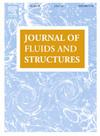Numerical simulation of the oblique water impact of double curvature bodies involving suction and cavitation phenomena
IF 3.4
2区 工程技术
Q1 ENGINEERING, MECHANICAL
引用次数: 0
Abstract
The present study aims to assess the capability of a numerical method to model hydrodynamic impacts representative of an aircraft ditching. The considered numerical method is based on the Finite Element explicit solver Radioss and a Coupled Eulerian–Lagrangian approach. The fluid–structure interaction is dealt with using an immersed contact interface and a penalty coupling method. The oblique water impacts of three different fuselage sections have been studied based on the experimental campaigns carried out during the European project SARAH at the High-Speed Ditching Facility of CNR-INM in Rome, Italy. The results are presented in terms of force coefficient, local relative pressure, and free surface elevation. The effect of the coupling stiffness and size of the fluid elements on the numerical results is analysed to assess the robustness of the numerical method. The numerical method shows a satisfying capability to reproduce most of the experimental results. Particular attention is given to the capability of the numerical method to describe the suction and cavitation phenomena. The effect of the specimens’ transversal cross-section, the specimens’ longitudinal curvature and the development of cavitation phenomenon on the hydrodynamic loads are also investigated.
涉及吸力和空化现象的双曲率体斜水冲击的数值模拟
本研究旨在评估数值方法模拟飞机迫降水动力冲击的能力。所考虑的数值方法是基于有限元显式求解器Radioss和耦合欧拉-拉格朗日方法。采用浸入式接触界面和惩罚耦合法处理流固耦合。基于欧洲项目SARAH在意大利罗马CNR-INM高速迫降设施进行的实验活动,研究了三种不同机身截面的斜水冲击。结果以力系数、局部相对压力和自由表面高程的形式给出。分析了耦合刚度和流体单元尺寸对数值结果的影响,以评价数值方法的鲁棒性。数值方法能较好地再现大部分实验结果。特别注意数值方法描述吸力和空化现象的能力。研究了试件横向截面、纵向曲率和空化现象的发展对水动力载荷的影响。
本文章由计算机程序翻译,如有差异,请以英文原文为准。
求助全文
约1分钟内获得全文
求助全文
来源期刊

Journal of Fluids and Structures
工程技术-工程:机械
CiteScore
6.90
自引率
8.30%
发文量
173
审稿时长
65 days
期刊介绍:
The Journal of Fluids and Structures serves as a focal point and a forum for the exchange of ideas, for the many kinds of specialists and practitioners concerned with fluid–structure interactions and the dynamics of systems related thereto, in any field. One of its aims is to foster the cross–fertilization of ideas, methods and techniques in the various disciplines involved.
The journal publishes papers that present original and significant contributions on all aspects of the mechanical interactions between fluids and solids, regardless of scale.
 求助内容:
求助内容: 应助结果提醒方式:
应助结果提醒方式:


